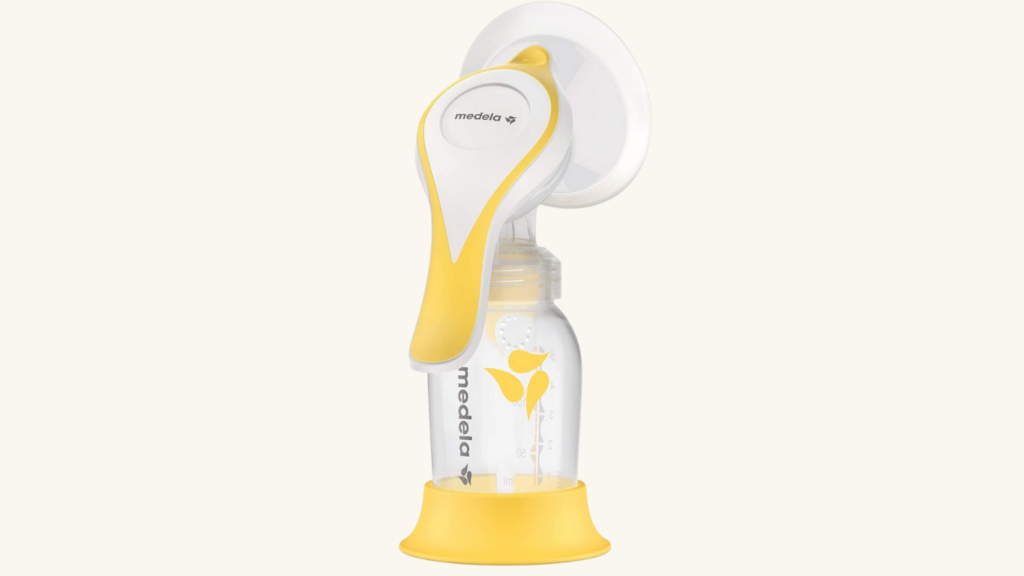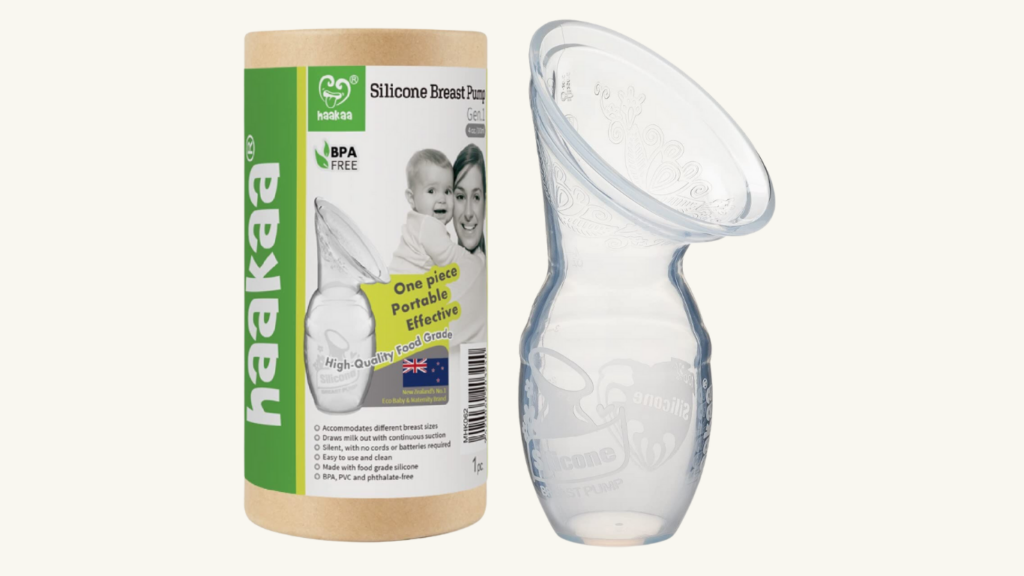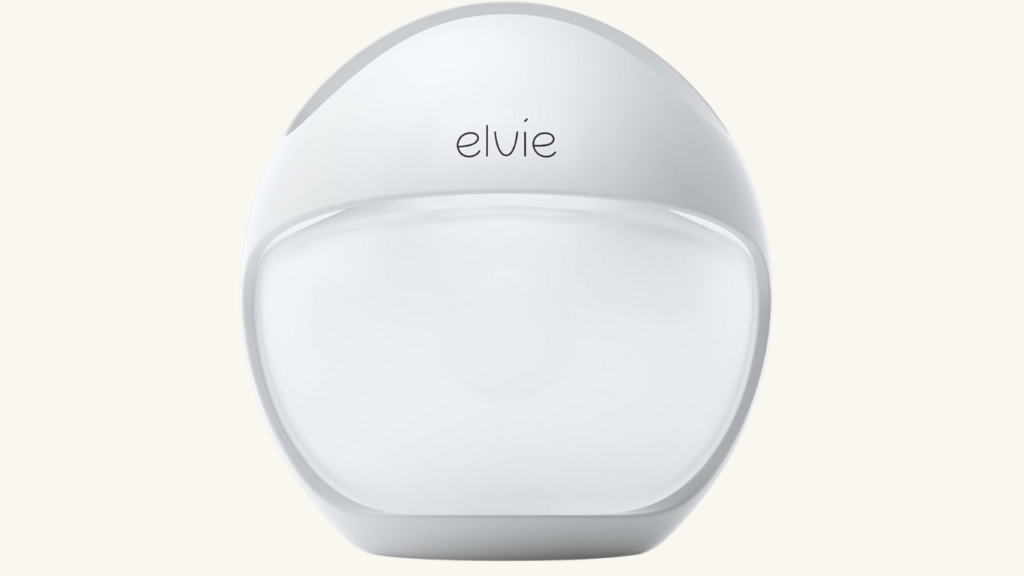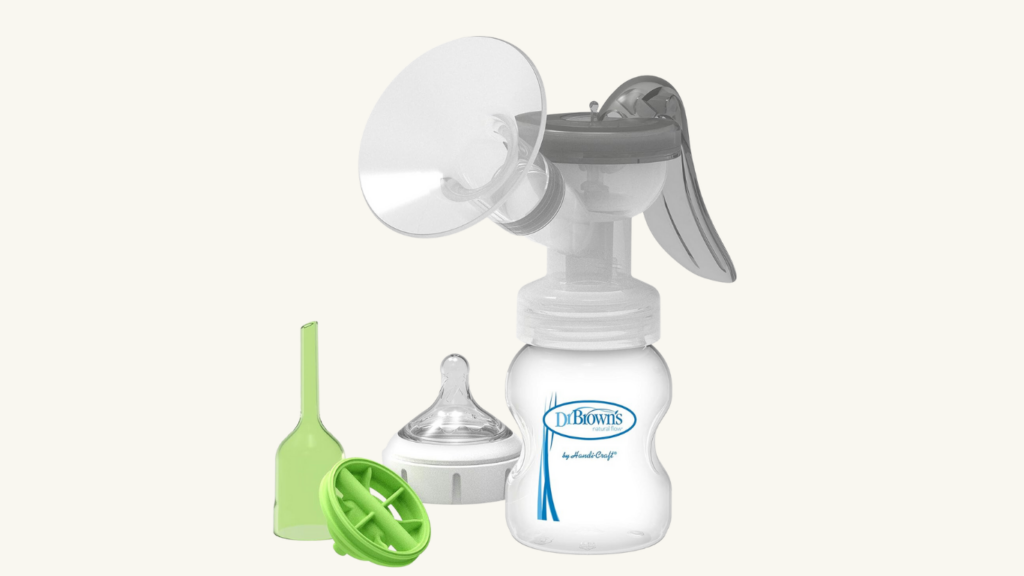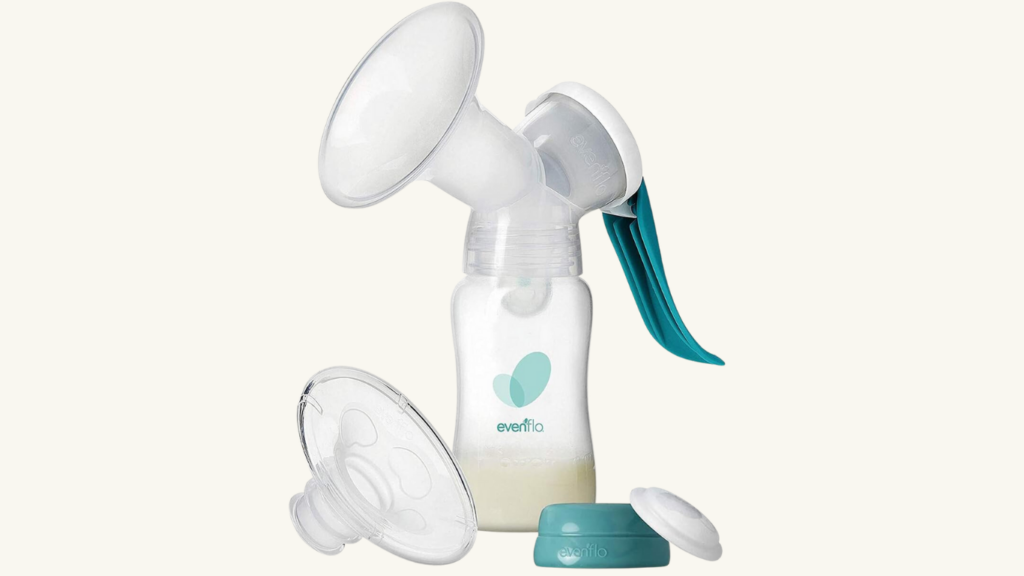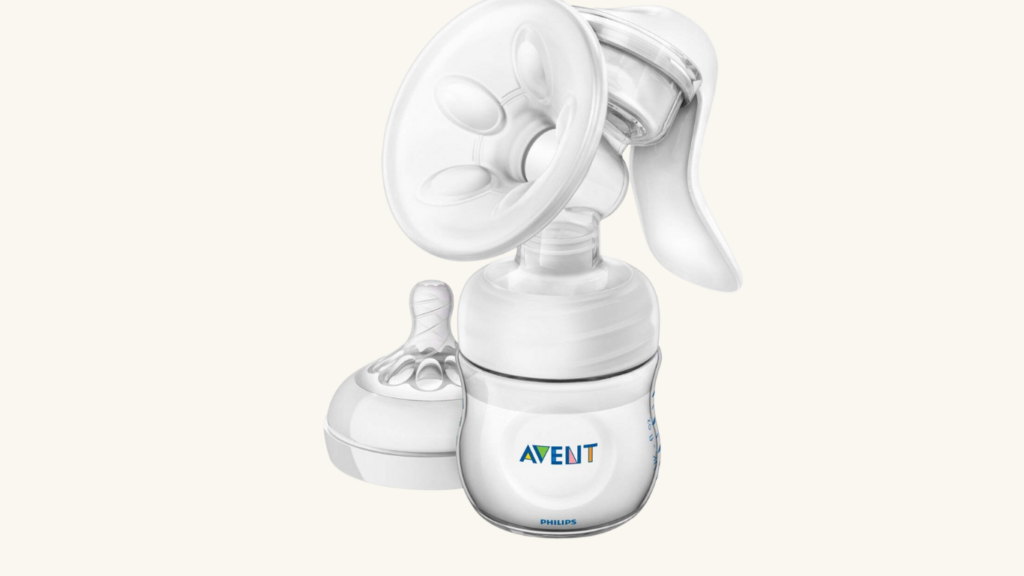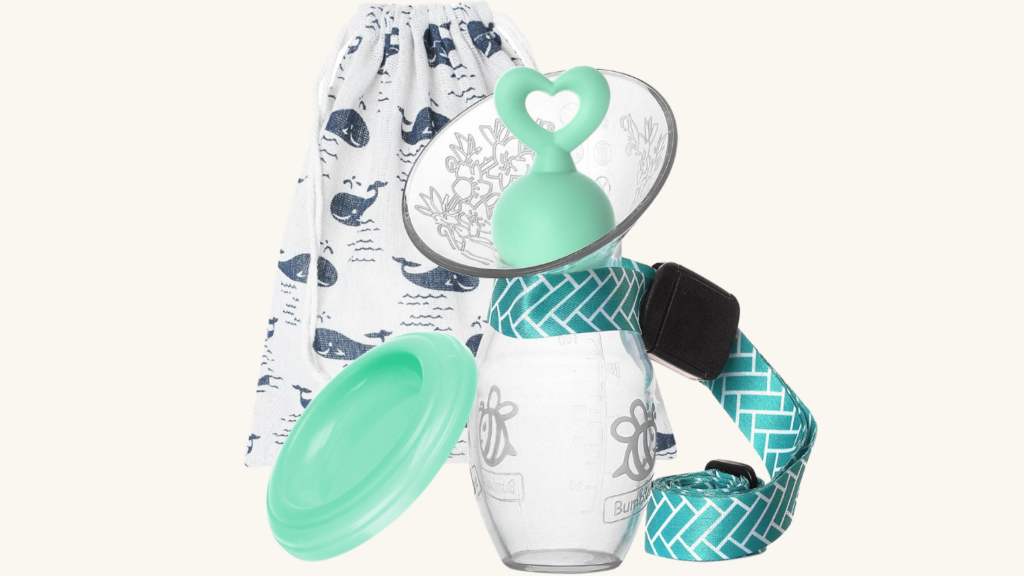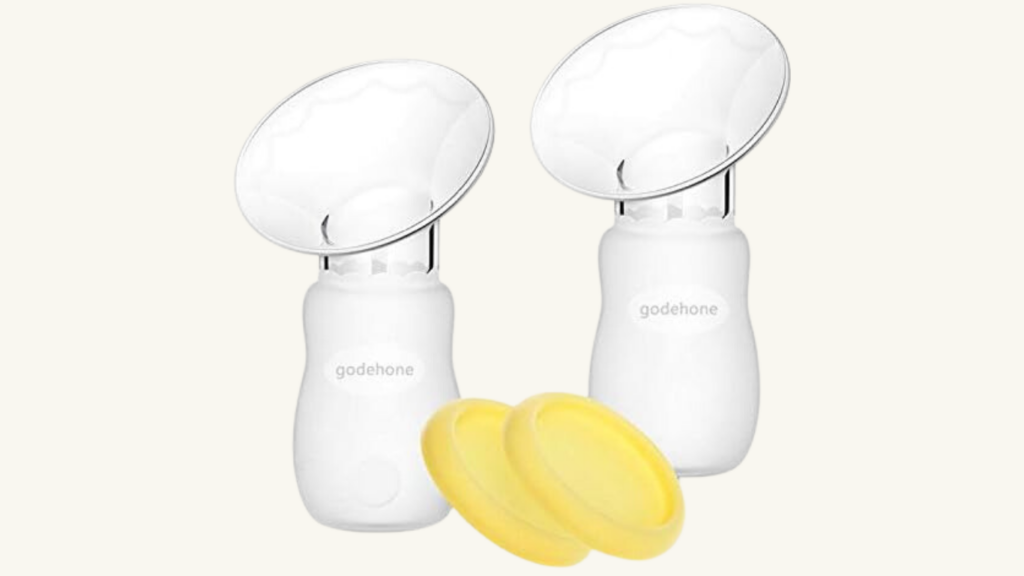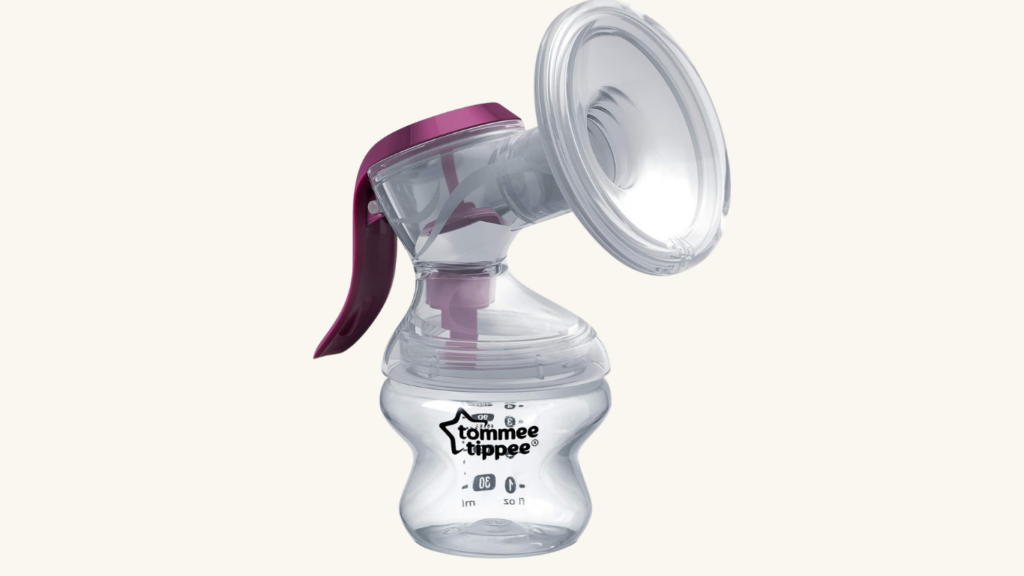While not exactly a necessity for nursing mothers, breast pumps can certainly ease the challenge, particularly for those balancing work and motherhood. They serve as an excellent tool to guarantee that your baby receives your nutrition-packed breast milk, sometimes affectionately referred to as ‘liquid gold,’ even in your absence. Additionally, top-notch manual breast pumps can aid in preventing unease or engorgement that can transpire due to skipping breastfeeding sessions.
Yes, electric breast pumps make milk pumping a breeze, but that’s until you can’t find an outlet to charge or run out of those fresh batteries. Then what do you do? This is one of the leading reasons why having a manual backup pump comes in handy. Additionally, manual pumps come in a durable construction that also costs less, well, that’s as long as you choose a reliable and good product.
But before you head out to get yourself the best breast pump for working moms, research the different options that are ideal for your breasts. This is one way to ensure that each pumping session is efficient and comfortable. On that note, also consider when you’ll be using the pump and where you plan on keeping it. Whether in your work purse or diaper bag, a compact option would be ideal.
What Is a Breast Pump?
A breast pump is a tool you use to extract breast milk for your baby if you need to leave them when going to work. This appliance guarantees your baby feeds on the best nutrients naturally found in your breast milk. You can get three types of breast pumps: a battery-powered pump, an electric pump, or a manual breast pump.
A manual breast pump is placed over your breast while you use your hand to manually ‘pump’ the lever and create suction in a motion that helps milk flow. They come in either single or double breast expressing models. This is quite an essential tool that will smoothen your breastfeeding process and let you hand over some feeding responsibilities to your partner or caregiver while you can rest or work.
A battery-powered or electric pump can eliminate the need to use your hand to operate the appliance. You will only need to place the suction cups on the breasts, and the pump does the rest, so they are ideal when you have something else you want to do. When buying an electric or battery-powered breast pump, you can choose between a single or double breast pump. A double breast pump is always ideal for saving time since it can extract milk from both breasts simultaneously.
Mothers who’ll need to pump multiple times a day may need to consider electric breast pumps, but if you’re only looking to pump occasionally, then the manual pump is the way to go. Manual breast pumps (hand pumps) are a low-tech but effective way to express milk for your little one. Also, unlike electric pumps, you won’t need to plug in or use a rechargeable battery as you’d need to with battery-operated electric pumps. Here, let us look at the very best breast pumps for working moms.
1. New Medela Harmony Manual Single-Hand Breastpump- Best Overall
The Medela pump is a compact and lightweight pump that’s your reliable go-to if you need to pump on the go. It comes with an oval-shaped shield, padded rim, and a 105° angle to help mothers easily find the right fit for their breasts. In addition, it uses a ‘two-phase’ technology that closely mimics the baby’s natural suckling motion so as not to interfere with the regular breastfeeding routine.
The Medela pump construction includes a diaphragm, handle, 1 Medela harmony connector, and stem with the ‘O-ring that helps make the manual pumping easier. It also includes a 24 mm breast shield, a breast pump, one 5-ounce collection bottle with a lid, a stand, and all the breast pump parts that you might need to set it up.
In the first stimulation mode phase, the 2-phase expression technology uses a lever closest to the breast shield to prepare your breasts for a liquid gold letdown. Once your milk begins to flow out, use the longer lever to help pump out the milk until you’re done.
To help make pumping sessions more efficient, the PersonalFit shield of the Medela pump has a soft and flexible rim that is clinically proven to help produce more milk.
PROS
- A 2-phase stimulation technology for efficient milk flow
- PersonalFit breast shields for comfortable milk production
- Quite affordable
- Easy to put together
- Lightweight and compact size that can fit in a large purse
- It’s not as noisy
CONS
- The suction power lessens over time
- Some users have reported that the o-ring on the pump breaks easily, so you may end up needing to replace it
2. Haakaa Silicone Breast Pump-Best Budget Pick
The Haakaa breast pump is also another favorite among many moms because it’s effective yet easy to use. It uses a simple suction method to pump directly into the collection can, so you won’t need to hand pump it. Simply, you only need to attach it to your breast, then squeeze once or twice, and the milk starts trickling out.
Alternatively, some moms like to attach it to one breast to catch the milk letdown and avoid having spilled milk while breastfeeding with the other. The fact that it is made of food-grade silicone makes it the best breast pump that’s safe for sensitive moms and babies. It also comes in just one piece, making it super easy to clean and easy to use.
To sterilize, just put the Haakaa in boiling water for 2-3 minutes. Moms can also use the Haakaa to clear their clogged ducts. Just fill the bottom with some warm water, not too much, so that you’re still able to attach it to your breast and one tablespoon of Epsom salt. Then attach it to the affected breast for the suction to clear the clog.
This manual pump is budget-friendly, can be safely washed in the dishwasher, is hot water safe, and can only have 4 ounces of milk.
PROS
- Comes in 1 piece
- Lightweight and portable
- Patented design
- Made of BPA 100% soft food-grade silicone that is Phthalate-free
- Easy use
- It can be washed using a dishwasher
- The flange that is designed to fit all breast sizes and shapes
- Can work for both pumping and collection of milk letdown
- Can be sterilized in boiling water in 2-3 minutes
- Compact and travel-friendly design
CONS
- It can only hold a few ounces of milk
- The operation needs some learning
- Comes with an open-top that can’t be used to transport milk
3. Elvie Curve Manual Wearable Breast Pump
Looking for a portable breast pump that also is a great alternative to the best double electric breast pump? You can get this Elvie Curve manual pump at a very affordable price. The silicone pump fits discreetly over your breast making sure you can pump on the move.
The pump is easy to use, considering you only need to press the silicone pouch to increase suction power. Then, the hospital-grade breast pump alternative is dishwasher safe, so you don’t have to clean it manually. You can buy a single pump or go for a bundle of two.
While easy to use and clean, the BPA-free breast pump also comes at a very affordable price. Additionally, it is comfortable on your nipples and comes with a limited manufacturer’s warranty.
PROS
- Affordable
- Easy to use and clean
- BPA-free food-grade silicone is safe for mom and baby
- Comfortable to wear
- The best breast pump for portability
- Easy to store
- Comes with a limited warranty
CONS
- It takes some getting used to control the best suction power
- You need to keep a close eye lest the milk overflows
4. Brown’s Manual Softshape Silicone Shield Breast Pump – Best for Small Nipples
Dr. Brown’s silicone manual breast pump comes with a 100% silicone breast shield that conforms to your body and shape. The pump helps you stay as comfortable as you need to be while using it. It is one of the best breast pumps for mothers with small nipples. Furthermore, it comes with an easy-to-use squeeze handle and 2 pumping modes that mimic your baby’s natural suckling motion.
All the parts of this silicone pump are top-rack dishwasher safe, and along with the pump, you get a level-1 nipple flange, a 5-ounce anti-colic wide neck bottle, a wide neck cap, and a cleaning brush that you can use when you need to handwash the parts after you have pumped milk.
PROS
- Soft, 100% silicone SoftShape Shield that conforms to the different breast shapes for a comfortable pump
- 2 pumping mechanisms to better mimic the breastfeeding motion
- Usefully comes with an anti-colic wide-neck bottle and a breast-like level 1 slow flow nipple
- All parts are BPA free and can be safely cleaned in the dishwasher
- Comes with a 5-ounce collection bottle
CONS
- Relatively pricey
5. Evenflo Advanced Manual Breast Pump – Best for Large Nipples
Here comes another manual breast pump that gives you both a 24.5-mm flange and a 30.5-mm flange. This is the best breast pump that comes in extra handy for someone with large nipples.
If these 2 sizes also don’t work, there’s an extra set of 4 additional size options that you can purchase separately. This is one of the best manual breast pumps for large breasts and nipples.
It is also lightweight and comes in a compact design with an easy-to-use handle pump that pivots for a comfortable hold on either the left or right side. Additionally, it also completely comes apart, so you can easily clean every crevice with no worry.
PROS
- A lightweight and easy to use a hand pump
- Travel friendly
- 2 flange sizes that are comfortably ideal for large nipples
- The pivoting handle easily allows the adjustment of your pumping position for extra comfort
- Comes completely apart for easy sterilization and cleaning
CONS
- Many parts for assembling and cleaning
6. Philips Avent Breast SCF330/30 Pump Manual
The popular Philips Avent manual breast pump is a comfortable and straightforward pump that doesn’t come in many parts, making it easy to use and clean. In addition, the flange comes with a soft ‘massage cushion’ to make the pumping process more comfortable. What’s more, there’s no need to lean forward to express milk in such an uncomfortable position since the pump works just as well when you sit up straight.
It is one of the best breast pumps designed for optimum comfort since it comes with an angled breast shield. This angled shield has a soft, textured cushion for a secure fit and to help stimulate the nipple. Additionally, it has an easy-to-use grip handle for pumping and an Avent bottle that is perfect for feeding your baby at home.
Lastly, it only comes in a few parts that make it simple to assemble and take apart when you need to clean.
PROS
- Unique design that allows a comfortable pumping position
- A soft, textured massage cushion that feels warm on the skin and helps stimulate milk flow
- Compact lightweight design that is easy to hold and position
- Compatible with other Philips Avent baby feeding products, such as the natural and anti-colic wide neck bottles
- BPA-free material construction
- Comes with a Phillip Avent natural feeding bottle and nipple
- Few parts for easy assembly and cleaning
- Easy to pump system and that expresses milk fast
CONS
- It is a bit squeaky while in use
- It doesn’t fit the standard sized baby bottles
7. BumbleBee Manual Breast Pump
This BumbleBee breast pump is another great option to have in your baby registry or cupboard. While it only collects 3.5 ounces of milk, it is still one of the most reliable pumps in the market and is easy to use with a storage bottle.
It comes with a silicone stopper and an anti-dust lid for when you need t store the milk. In addition, the silicone breast shield feels soft on your skin and can even soothe broken or sore nipples. Finally, the breast pump is safe for the baby as it will not interfere with the nutrient content in your breast milk.
The lightweight pump is also great for use when your little one is asleep as it is noiseless. Then, it is easy to use by squeezing the bottle to improve suction, and you can clean it with a brush and mild soap.
PROS
- Easy to use
- Made with safe materials
- The breast shield is great for sore nipples
- Affordable
- Comes with a silicone stopper plus an anti-dust lid
- Available with different-colored lids and stoppers
CONS
- It is best to hand wash the pump
8. Godehone Silicone Breast Pump 2 Pack
One big advantage of using the best manual breast pump for working moms is their quiet operation. If you are a new mom looking for the most effective breast pump, this Godehone silicone breast pump is an ideal option.
It is made with soft, BPA-free silicone for your and your baby’s safety. In addition, the package comes with two bottles with powerful suction cups and anti-dust lids. You will only need to press on the bottle to improve suction, and when you are done collecting, you can feed your baby directly or store the bottles in the freezer.
The breast pump is easy to clean by hand using a mild soap. Also, the bottles are easy to store and portable to bring to a trip. If the bottles do not satisfy your needs, the company promises full refunds.
PROS
- Easy to use
- BPA, PVC, and Phthalate-free
- Portable breast pump
- Comes with anti-dust lids for easy storage
- Quiet operation
- Quite affordable
- Excellent return policy
CONS
- You need to hand wash the parts
9. Tommee Tippee Made for Me Single Manual Breast Pump
It is one of the best breast pumps when you need an easy-to-use, manual option. It comes with a 5-ounce feeding bottle plus a slow flow nipple, while the silicone breast shield hugs your breast for stress-free pumping.
It is made with safe silicone, BPA, phthalates, and PVC-free materials, so you know you will not compromise nutrients in your breast milk. In addition, the manual breast pump is compact enough for traveling, while the squeeze handle is placed ergonomically for easy use.
The breast pump is affordable and ideal for massaging your nipples to alleviate stress. It uses cushioned silicone horn that is gentle in sore nipples. You can feed your baby immediately or store the bottle in the freezer for later consumption when you finish pumping. Also, you can toss the parts n the dishwasher for thorough cleaning.
PROS
- Affordable
- Easy to clean in the dishwasher
- Comes with a durable bottle that is also ideal for storing the milk
- Best for soothing sore nipples
- Ergonomic squeeze handle
- Noiseless operation
CONS
- It has a lot of parts to clean
Factors to Consider when Buying the Best Manual Breast Pump
a) Fit Options
How comfortable the pump is affects milk flow and milk volume on manual pumps. So always look for something perfectly made for your breast size or one that comes with different shield options for you to find the best fit. Unfortunately, the pump won’t work or collect milk if it has a tendency to lose suction and doesn’t hold onto your breast, so the fit is quite important.
Mothers with large breasts should opt for a breast pump that comes with multiple flange size options.
b) Easy to Clean/Hygiene
It’s also imperative to find a pump that you can thoroughly clean easily. If not well-cleaned, bacteria will quickly grow and, through the milk, get passed on to the baby. Always consider the best breast pumps that are easy to take apart or come as one big piece without many crevices in the structure. To help kill these bacteria, get a pump that can also be cleaned in the dishwasher safely after each use.
When cleaning, it is also best to avoid using harsh ingredients that may not come off after rinsing. Harsh soaps and detergents will leave traces on the breast pumps, and these will make their way into that milk and your baby’s tummy eventually. Additionally, it is best to look for breast pumps made with BPA, PVC, and phthalate-free materials such as silicone to maintain the nutrients in your milk.
c) Efficiency
Manual pumps are only as good as their efficiency in expressing milk. So when looking for the best manual pump, always be sure to read through the user reviews to help you get an idea of the efficiency. In addition, some breast pumps might need some learning, while others might be a little straightforward to use right out of the box.
Not being able to use both manual and electric pumps properly won’t give you the full benefits of these pumps. Also, purchase the pump from retailers with a flexible return policy if the one you get doesn’t work for you.
d) Extra accessories
When buying manual breast pumps, the biggest dealbreaker is that you have to do all the work. You are prone to suffering hand fatigue which can affect how much milk you extract. So, when buying the best breast pump for working moms, look for one that comes with the following accessories.
- Bottles. The best breast pump for working moms needs to reduce the work involved. So, one that comes with a bottle is easier to work with since you can ump directly into the bottle and in turn, you won’t have to spend more time transferring the milk for storage. In the case of manual breast pumps, your tired hands will appreciate less work.
- A stand. When you need to go back to work, you will obviously be expressing milk daily, and if using a manual pump, this can quickly turn into your most-dreaded daily session. So, with a stand, you eliminate the tiring work of packing and unpacking your breast pump with easier storage.
- A carry bag. Your best breast pump for working moms is highly portable, so look for one you can take to work. A carry bag makes it easier to keep the pump safe from other unclean items you use daily.
- Different breast shields. As you continue nurturing your baby since pregnancy, you will experience many changes to your body, and these will include your breasts. It is common for breasts to change sizes with different hormonal changes. So, if you need breast pumps for the long term, you will need different breast shields to use in tandem. A package that comes with different breast shields will guarantee you can use the pump for a long time because you will only need to change the shields as your body transforms.
Electric vs. Manual: Which is the Best Breast Pump for Working Moms?
As you know by now, there are two main types of breast pumps determined by how you operate them. A manual breast pump is hand-operated, while an electric breast pump needs electricity or battery power to pump. But, as you look to complete your shopping, which one is actually best for you? We look at the advantages and disadvantages of both here.
1. Electric breast pumps
These may be the best options for working moms for the following reasons;
- They have different modes for milk extraction and breast massage
- They work fast
- They are often hands-free, so no hand fatigue
- They can imitate a baby’s sucking to get the most milk
But, while they look to be more effective, these electric best breast pumps have the following disadvantages;
- They are quite expensive
- They increase your energy bill
- You can only pump when there’s power or have recharged batteries
2. Manual breast pumps
As a working mom, you might think these are not the best breast pumps due to the work involved when expressing milk. But in the long term, these pumps may prove to be better because;
- They are affordable
- They are lightweight and portable so that you can express milk at work
- They are straightforward to use
- They are durable since all parts come off when not in use
- You can use them any time you need to pump
Despite the good features and reliability, here are some reasons you might want to stay clear of a manual breast pump;
- They cause hand fatigue since you have to press the bottle for suction manually
- You can only express breastmilk from one breast at a time
Pro Tips for Using Your Best Breast Pump for Working Moms
Are you a new mom or finishing up on your baby registry? Learning to use the best breast pump is paramount to keeping your baby fed and preserving the breastmilk. In this section, we will cover some essential tips on using a breast pump to the maximum effect.
Pumping milk may require getting used to before you produce enough to feed your baby. But, with these pro-mom tips, you can lessen the time needed to get started, as well as mitigate the risk of infections if you have too much milk. In addition, pumping is a great way to ensure your baby feeds healthy while you stay away at work.
- Do not rush into pumping immediately after birth. During your first days as a mom, you need to establish a good bond with your baby, and the easiest way to do so is through breastfeeding. So, unless you do not intend to breastfeed your baby, or if your baby can’t latch for whatever reason, it is better to start with breastfeeding them, then slowly transition to pumping as your parental leave is almost up. Breastfeeding stimulates your body to produce more milk, so doing so at first will guarantee you have a healthy supply even when you need to pump.
- Start with 15-minute pumping sessions. If you need to start pumping after birth, it is best to time the sessions with when your baby would start breastfeeding, so in the first few hours. Alternatively, if you need to start preparing to leave your baby as you head back to work, you will need to start with timed sessions, even if you don’t produce much milk. Like breastfeeding, regular pumping will stimulate your breasts to produce more milk, so you do not need to worry if it’s the only way to feed your newborn. If you have been breastfeeding for a month or so, you may find it better to suction about an hour after feeding your baby to produce the most milk.
- Keep high levels of hygiene. Before any pumping session, you will need to ensure the breast pump is clean and sanitized to maintain the integrity of your milk. Also, you will need to wash your hands as you will also handle the milk at some point.
- Prepare for your pumping session. Suctioning milk is very similar to breastfeeding, so you will need to have everything ready, including the breast pump, storage bottles or bags, and snacks if you need any. You can also have your mobile phone or TV remote next to you to reduce any likely interruptions. If you want to pump from home, you will also need someone looking after your baby in case they need attention during the session.
- Pick a comfortable place. When everything is ready, make sure you settle at a relaxed place and on a comfortable seat, preferably somewhere private and comfortable. If using a manual pump, you will also want to avoid holding many things so you can use your hands. Alternatively, when you might be using a hands-free breast pump, you will still need to relax even if doing something else. It can be ideal to listen to calming music or have your partner massage your shoulder to help you produce the oxytocin hormone that will help you relax. Some moms also find that keeping the baby’s item ( like a photo or blanket) close will help stimulate the natural feeling of bonding with them, which will help you relax, and, in turn, produce more milk.
- Kick-start your let down. If using a single or double electric breast pump, you might find the process easier if the breast pump imitates your baby’s suckling; usually, a baby starts with fast, light suckling and transitions to slower and stronger sucks as they get full. A pump with this feature can help with your let down, but using a manual pump, you can do a few things, suck as cuddling your baby before the session, massaging your breasts, or applying a warm compress to stimulate milk flow.
- Track your let down. When using a single or double electric breast pump, it is crucial to track your milk flow so you can choose between the two modes. The first stage is mostly stimulation, and so, when you start noticing a constant milk flow, you can switch to the expression mode to produce more milk. When using a manual pump, you will also need to start pumping fast but lightly, and once you get a constant milk flow, perform slower but deeper presses to get the most milk.
- Adjust your pumping sessions. This pro tip requires you to monitor which times you produce the most milk when pumping and stick to that time for most consequent pumping sessions. If you have bottle-fed your baby since birth, you will notice these results faster since you will probably pump several times a day. But, as a working mom needing to leave enough milk for your baby in the freezer, you will need to study your let downs closely to pick a good pumping time. Then, when you know which time you produce the most milk, it is best to study your let down to know how long you need to pump. If you have one early let down, you will need shorter sessions to avoid hurting your nipples after draining the milk. But, if you have more than one let downs, you can pump for more than 15 minutes to drain your breasts completely.
- Start using a double breast pump more often. As a working mom who needs to get t work on time, nothing beats leaving enough breast milk for your little one. So, getting a double breast pump is worthwhile; it saves you more time pumping compared to when you pump one breast at a time. But, that’s not all; a manual breast pump or a double electric breast pump raises the level of the milk-producing prolactin hormone in your body. This way, you will produce more fat-rich (thus healthier) breast milk for your baby in lesser time. In addition, most moms find double pumping increases their milk supply.
- Prioritize comfort. It may sound like a selfish move, but if you experience any discomfort, you need to reconsider the options; you can adjust the suction power, invest in a new breast pump, or stop pumping for a while. If pumping hurts, you are likely using high suction power, and reducing it can alleviate the discomfort. Another reason why pumping could hurt is if you use a small breast shield. It is the part that hugs your breast, but it should leave enough room for your nipples to move back and forth. If you find this to cause pain, you can invest in a larger breast shield. Finally, if you try both remedies but continue with discomfort, you can stop pumping and consult a lactation consultant for advice.
How to Pump Milk at Home with the Best Breast Pump for Working Moms
As seen above, pumping milk is a craft that needs perfecting every time. If you are preparing to go back to work, you will need to start pumping weeks before the return date and store the milk in the freezer for the best preservation. However, getting started requires you to understand the main types of breast pumps better so you can use them to your advantage.
Electric breast pumps can either be plugged into a source or come with rechargeable batteries to power them. These pumps could be a great addition to your baby cupboard as a working mom; they can imitate your baby’s suckling to produce more milk in the least time possible. In addition, they are hands-free, so you can pump while putting on your makeup or preparing for work in another way. However, these breast pumps are noisy and not ideal when you look to lower your energy bill.
Manual breast pumps are noiseless in operation, but they require you to press them to produce suction power manually. While they are easy to use and save energy bills, these pumps can leave you with tremendous hand fatigue. In addition, you will need to time your pumping sessions, so you get enough time to also prepare for work. However, these manual breast pumps are the most affordable and durable as there is little risk of damaging them.
Hospital-grade pumps are better than the two main types, and they are ideal for moms who have to pump immediately after giving birth. A hospital-grade pump has a stronger suction from a powerful motor and special programming that allows mothers to get the most milk regardless of any medical conditions they have or their babies have. Compared to a manual pump or electric breast pump, hospital-grade pumps are more expensive but are easily the most effective when you also need to prevent breast problems.
With the information out there, it is time to get down to pumping business. Settled in your nursing glider? Here are the steps you need to follow for the best results.
- Read the instruction manual. Most breast pumps come with an instruction manual telling you how to use and clean them.
- Observe hygiene. Before you start pumping, it is best to wash your hands as you will handle the milk before your baby drinks it. In addition, if you want to pump after a long day at work, you can take a shower to make sure no sweat or perfume will contaminate the milk. Finally, ensure all parts are clean and sanitized.
- Center your nipples. Every breast pump comes with a breast shield. You will need to center your nipple in the flanges, ensuring you leave enough room for nipple movements when pumping. For this, you will need the right-sized breast shield to prevent rubbing and friction. To center your nipple, you might need to lean forward a bit and, with the breast shield folded, use one hand to put your nipple in place. When content, unfold the breast shield and make sure it hugs your breast tightly to avoid losing suction power.
- Start pumping at the lowest speed. To ensure you have the best fit for your breast and nipple, start pumping slowly to see if the breast shield holds. Then, when you are sure everything is okay, pump to imitate how your baby sucks for the best milk production. Using manual breast pumps, start with fast and light presses to encourage better milk flow. Then, once you get the best let down, you can switch to slower, deep presses to get the most milk. Using this method, your breasts will produce a good amount of milk, similar to how your baby simulates better milk production.
- Pump for seven minutes at first. Since you are imitating how your baby feeds, it is best to take a minute in between before switching the suction power. So, press your breast pump lightly, but first for seven minutes, and then, after you get a steady milk flow, stop for a minute to massage your breast. After that, continue pumping with slow, deep presses for another seven minutes or until you no longer produce milk.
- Feed the milk or store it for later consumption. Once you finish pumping the milk, you can decide to feed it to your little one, or, if you are stocking up for when you go to work, cover it with an anti-dust lid and store it in the freezer. If you want to feed your baby instantly, always ensure the milk is warm at a baby-safe temperature.
Frequently Asked Questions on The Best Manual Breast Pump
a) Does a manual pump help you get more breast milk?
Manual pumps can help you remove more breast milk. Some women can express more milk when using a manual pump mechanism than they can with a rechargeable battery electric pump; however, women are different. If you’re a mom struggling with low milk supply while using an electric pump or having trouble and need to maintain milk supply, it is highly recommended that you ease off the electric pump give the manual breast pumps a try.
b) Do manual breast pumps decrease your supply?
The continuous use of a manual pump can cause the depletion of your milk supply. With this in mind, manual breast pumps should complement normal breastfeeding in most cases. In addition, the best manual breast pumps help working mothers ensure that the baby gets enough milk when they are away.
c) Can you pump both breasts and transfer milk in 1 bottle?
Using a double pump, pumping both breasts at once can give you a total amount of milk that will fill 1 bottle no more than two-thirds full. You cancarefully combine these contents in 1 bottle from one sterile container to another. However, pumping mothers shouldn’t combine milk collection from different pumping sessions, especially sensitive babies.

